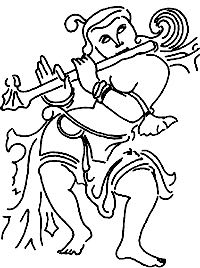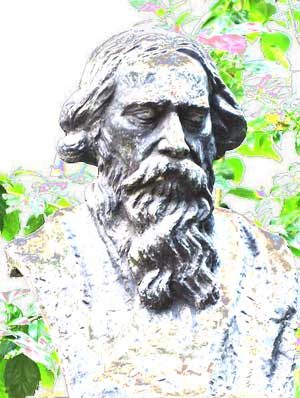
The flute has played a key role in India’s artistic life since antiquity. This is evident from writings on dance-drama, mythology, sculptures and paintings. Its playing technique must have been highly developed for a very long time. Different names are used for it, for instance kuzhal (pronounced like “kulal” or “kural”) in Tamil speaking regions; and bansuri in northern India. In poetry, song lyrics, classical dance items and films, words like venu and murali evoke its association with Krishna, the ‘dark skinned’ cowherd and flute player. […] Tagore’s poetry reminds us of the fact that reed and bamboo flutes are the world’s most “democratic” to this very day, both literally and figuratively:

image by L. Pesch
“Very often I think and feel that I am like a flute – the flute that cannot talk but when the breath is upon it, can sing.” – Rabindranath Tagore whose pioneering institution Santiniketan inspired Kalakshetra
Learn more
In his poetry, for which he received the Nobel Prize for Literature as Asia’s first awardee in 1913, Rabindranath Tagore uses musical instruments as metaphors for self-realization and transcendence; notably the vina (or “veena”, often translated as “harp”) and the flute. In a letter to Frederik van Eeden, his Dutch translator, he wrote:
“Believe me, my friend, my heart goes out to you but I am inarticulate. I have to speak to you in a language not my own. The best that I have in me I give out in songs – no, I can not even say that I give it out – it comes out of itself. The superconscious self of mine which has its expression in beauty is beyond my control – and my ordinary self is stupid and awkward before men. Very often I think and feel that I am like a flute – the flute that cannot talk but when the breath is upon it, can sing. I am sure you have seen me in my book and I shall never be able to make myself seen to you when we meet; for the body of the lamp is dark, it has no expression, only its flame has the language.”
Source: “Tagore in The Netherlands” by Liesbeth Meyer (Letter#2: Rabindranath to Van Eeden, August 9, 1913, seven years before his spectacularly successful visit to the Netherlands)
https://www.parabaas.com/rabindranath/articles/pMeyer.html
Tip: The Golden Book of Tagore (70th birthday) | PDF-Repository (30 MB) >>
Search for “flute” to find out more about Rabindranath Tagore’s deep involvement in music (e.g. Page n258):
“Hence his songs and stories stir our hearts as do great folk-songs, telling, as they do, of the joys and sorrows of every man and of every woman. Through Rabindranath, India’s humblest villagers speak to the world. To be the flute of God and to be the flute of men likewise, what nobler end can a poet achieve?”